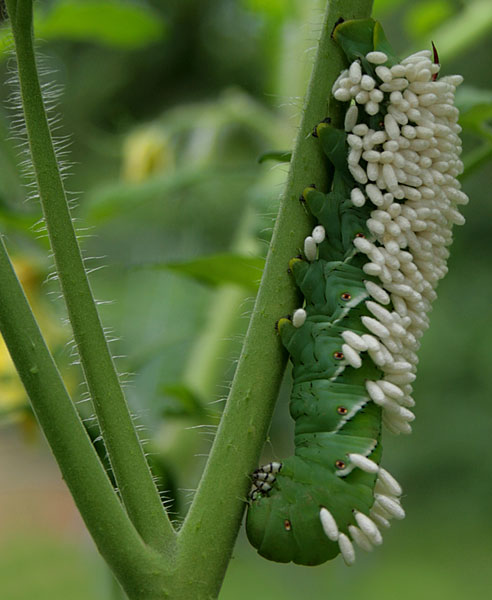Haha may have been the eggplant after all! That's okay, though. Anything to protect the tomatoes. I want homemade sauce! But I was out checking moisture levels of the soil and watering yesterday and noticed a frikken hornworms on one of my plants. Pulled that sucker off right away. Didnt see another but went out scouting a few minutes ago and there was another. I was shocked at how big they actually are. Seeing photos I thought they were magnified....didn't realize how BIG those things actually were! And easy to miss. So I'll be out there a couple times a day scouting for others. But for the most part the garden is finally flourishing!Lindsaylew82 wrote:(It was the eggplant!)
I'm glad things are looking up for you!!!
- TexasGardenGirl
- Cool Member
- Posts: 62
- Joined: Fri May 06, 2016 11:01 am
- Location: Raeford, North Carolina, zone 7b
Re: Tomato issues *again*
- rainbowgardener
- Super Green Thumb
- Posts: 25279
- Joined: Sun Feb 15, 2009 6:04 pm
- Location: TN/GA 7b
Do you have flowers in, around, near your garden?
There is a tiny, stingless wasp, called a braconid, that parasitizes hornworms and other garden pests. The wasp lays her eggs inside the caterpillar and they eat their way out. The adult wasp lives on nectar and pollen and needs flowers that have their nectar in tiny florets. These include sweet alyssum, chamomile, feverfew, catnip and buckwheat. When allowed to produce flowers, dill, fennel and other members of the carrot family also attract braconid wasps.

If you see a hornworm looking like this, leave it alone. Those are the braconid larvae when they have emerged and pupated. That hornworm is dying or dead. If the white cocoons have holes at the top, the adult wasp has already emerged to carry on the good work.
In my garden before I moved, I hardly ever saw a hornworm that had not been parasitized already. The braconids are a very effective part of the Garden Patrol, even though I have never actually seen one.to know I was seeing it. Depending on the species they are a tenth of an inch to less than half an inch long.
this is magnified:

There is a tiny, stingless wasp, called a braconid, that parasitizes hornworms and other garden pests. The wasp lays her eggs inside the caterpillar and they eat their way out. The adult wasp lives on nectar and pollen and needs flowers that have their nectar in tiny florets. These include sweet alyssum, chamomile, feverfew, catnip and buckwheat. When allowed to produce flowers, dill, fennel and other members of the carrot family also attract braconid wasps.

If you see a hornworm looking like this, leave it alone. Those are the braconid larvae when they have emerged and pupated. That hornworm is dying or dead. If the white cocoons have holes at the top, the adult wasp has already emerged to carry on the good work.
In my garden before I moved, I hardly ever saw a hornworm that had not been parasitized already. The braconids are a very effective part of the Garden Patrol, even though I have never actually seen one.to know I was seeing it. Depending on the species they are a tenth of an inch to less than half an inch long.
this is magnified:

- TexasGardenGirl
- Cool Member
- Posts: 62
- Joined: Fri May 06, 2016 11:01 am
- Location: Raeford, North Carolina, zone 7b
Before I pulled the hornworm off my tomato plant, I checked for signs of the wasp eggs and saw none. So I took it off. I do have chamomile in one of the beds but it's not flowering at all. It's not wilting, it's nice and green, etc. but it just hasn't flowered. *shrug* But the hornworms aren't an issue to pull off. Easier to get rid of than the darn flea beetles and easier than having to constantly watch my darn dog to keep her from eating my zucchini leaves/blooms. I am ordering some BT tomorrow since it's payday. Gotta keep those pesky caterpillars away!rainbowgardener wrote:Do you have flowers in, around, near your garden?
There is a tiny, stingless wasp, called a braconid, that parasitizes hornworms and other garden pests. The wasp lays her eggs inside the caterpillar and they eat their way out. The adult wasp lives on nectar and pollen and needs flowers that have their nectar in tiny florets. These include sweet alyssum, chamomile, feverfew, catnip and buckwheat. When allowed to produce flowers, dill, fennel and other members of the carrot family also attract braconid wasps.
If you see a hornworm looking like this, leave it alone. Those are the braconid larvae when they have emerged and pupated. That hornworm is dying or dead. If the white cocoons have holes at the top, the adult wasp has already emerged to carry on the good work.
In my garden before I moved, I hardly ever saw a hornworm that had not been parasitized already. The braconids are a very effective part of the Garden Patrol, even though I have never actually seen one.to know I was seeing it. Depending on the species they are a tenth of an inch to less than half an inch long.
this is magnified:
